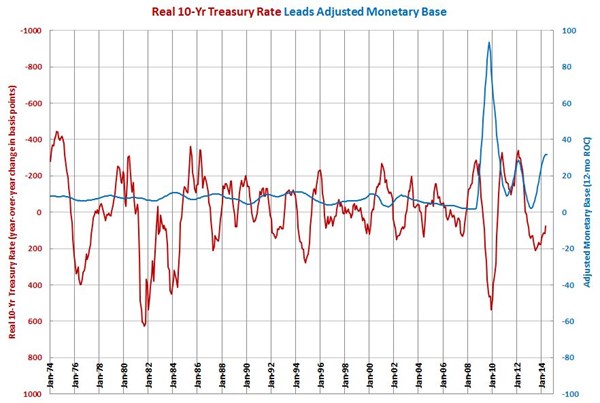Money Supply Continues to Grow at Slower Rate
In May 2014, the monetary base was $3.966 trillion dollars. That is 23.2% more than it was in May 2013.
In May 2014, the monetary base was $3.966 trillion dollars. That is 23.2% more than it was in May 2013. This is the seventh straight month that the month-over-month rate of change has declined, and this is the slowest rate of month-over-month growth since June 2013. The annual rate of change remained unchanged from last month at 31.6%. It seems we have hit the peak rate of annual growth in the money supply.
Historically, changes in the monetary base lead changes in capital equipment spending by about two years. With the Fed apparently committed to ending QE, and perhaps even raising interest rates early next year, it appears that the money supply will indicate slower growth or contraction in capital spending for 2015 and perhaps 2016. However, the extreme changes in monetary policy by the Federal Reserve are making it difficult to match up the correlation between the monetary base and machine tool sales the past several years. The correlation of cycles seems to differ somewhat depending on whether you are using machine tool unit sales or real dollar sales of machine tools. You can see how the monetary base leads various machine tool sales and consumption data as well as primary plastics processing equipment at our monetary page.
The real 10-year treasury rate is a good leading indicator for the adjsuted monetary base. Historically, changes in the real 10-year treasury rate have led changes in the monetary based by about 15 months. This is because banks increase their lending due to lower rates that leads to increased deposits that then lead to a need for increased reserves. (Yes, this is the opposite of what many of us think happens - that banks increase their deposits and then lend those deposits.) From early 2012 to the middle of 2013, the 10-year treasury was increasing at a rapid rate. I think this will correspond to a significantly slower rate of growth in the monetary base from June 2014 until some time in the first half of 2015 (or, how long the Fed will be able to stand a shrinking economy in terms of GDP and perhaps a falling stock market).



.JPG;width=70;height=70;mode=crop)